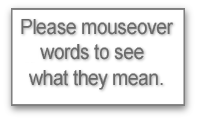Science news - plant circadian clocks
15-September-2010
 Plant circadian clock
Plant circadian clock
It’s not obvious to pupils in school that the aim of a science experiment is to learn something you didn’t know, says Hugh Nimmo. “I even get undergraduates in the lab wanting me to tell them what the right answer is. The whole point of an experiment is that the right answer is the one you get.”
But before getting any answers a researcher has to think of a good question. This is where most people's idea of a scientist and the real thing are very different, says Professor Nimmo. “Because what you need at that stage is imagination. So the picture of a scientist as rigid, unbending and following procedures like a robot couldn’t be further from the truth.
“Science works by people having new ideas then testing them. You take a problem, say a bit of biological behaviour, and imagine a possible explanation, in terms of things you know and some you don’t know. 
Imagination
“To my mind that’s as difficult as having the concept for a great novel. Hilary Mantel won the Booker Prize for Wolf Hall and her concept was that you could write a fascinating story about Thomas Cromwell, who’s usually seen as nasty individual. She saw that he rose from a low background, was educated broadly in Europe, spoke loads of languages and had lots of skills. Having that concept was a great act of the imagination.
“But thinking of possible answers to scientific problems is an exercise of the imagination of a similar nature. The difficult part of science is having the concept in the first place. The most rewarding part of science is doing the experiment and discovering you were right, and you go ‘Wow! - the world now knows something it didn’t because of something that came out of my head.’”
An example from his own research is circadian clocks – the mechanisms in plants and animals that measure the passing of time.
Rise and shine
Why are these mechanisms important? Well a plant that knows when the sun is going to rise can get itself wide awake and ready to photosynthesise. It can steal a march on its sleepier companions. This is why circadian clocks are found in all higher plants.
But the way these clocks work is not well understood. For a long time scientists thought all cells contained clock machinery that worked the same way but ran independently, without communication between cells or organs, says Professor Nimmo. “And there was evidence to support that. But I took a different view."
One of the main roles of the circadian clock is to control metabolism, he points out. But metabolism varies throughout the day in different organs. "So my feeling was that a leaf, say, would have a different timing requirement to a root.
Clocks communicate
He devised an experiment to test this, by looking separately at shoots and roots of Arabidopsis thaliana plants. The simplest plant clock would be a feedback loop consisting of a protein expressed by a gene that gets switched off when the protein has built up to a certain level.
In practice plant and animal clocks usually consist of several interlinked protein and gene feedback loops that have to be studied. But the principle is the same. So scientists can study clocks and their timing in any organ by taking samples and measuring the expressed protein levels throughout the day. Professor Nimmo and his colleagues used a technique for this known as quantitative real-time reverse transcription polymerase chain reaction.
that have to be studied. But the principle is the same. So scientists can study clocks and their timing in any organ by taking samples and measuring the expressed protein levels throughout the day. Professor Nimmo and his colleagues used a technique for this known as quantitative real-time reverse transcription polymerase chain reaction.
The results showed very convincingly that their hypothesis was correct. There is communication between the clocks of different plant organs.
Climate change
This was an extremely satisfying result, says Professor Nimmo – as well as being potentially very useful. “With climate change we want to be able to change the latitude at which particular crops can grow and produce. As the planet warms it would be nice if we could grow rice, say, further north. Now plants use their circadian clocks to measure how day-length changes throughout the year.”
This in turn lets them work out which season it is and when they should flower. “So if you move a strain of rice a hundred miles north - where the way the day length changes is different - it will flower at the wrong time.”
The result is greatly reduced crop yield – and maybe none at all if the plant is completely out of synch with the insects that pollinate it. “So one application of the knowledge we are gaining, using genetic engineering or even normal selective breeding methods, would be crops that grow well further north.
"A better understanding of circadian clocks could be very important for all of us."
More help with words
| cell | conception | DNA | environment | fertilisation | gene |
| inherit | membrane | molecule | pollen | offspring | process |
| protein | protoplasm | reproductive | response | system | tentative |
For other websites and resources relevant to this science story try the

